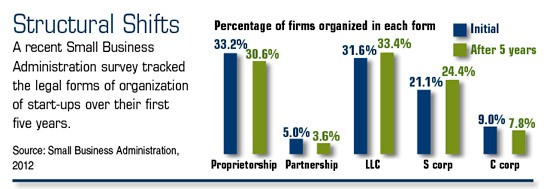A small business can adopt a number of business structures for tax and legal purposes. Each has its own advantages and disadvantages. Sole proprietorships, partnerships, and limited liability companies (LLCs) are fairly basic forms of ownership, whereas corporations are significantly more complex.
There are two primary types of corporations in the United States. C and S corporations may provide broader legal protections, but usually must meet more demanding legal requirements. Some states also recognize benefit corporations, a new legal structure that tends to appeal to “social entrepreneurs.”1
A corporation is a separate legal entity from its owners, a distinction that explains why shareholders generally cannot be held liable for a corporation’s debts.
Tried and True
Introduced in 1958, S corporations were originally intended to offer tax relief to small, privately held companies.2 S corps share many of the formal corporate requirements as C corps, including articles of incorporation (and other document filings), a board of directors, an annual meeting, corporate minutes, and shareholder votes on major decisions. S corps are limited to one class of stock and a total of 100 shareholders.
The primary difference between C and S corporations has to do with taxation. C corps may be subject to corporate income tax at both the federal and state levels, and any earnings distributed to shareholders as dividends are taxed again at personal income tax rates. S corp profits and losses are “passed through” to shareholders, who are taxed at individual income tax rates. Both types of businesses must file annual tax returns.
 An Idealistic Newcomer
An Idealistic Newcomer
Seven states have passed benefit corporation laws in the last two years, and at least four others are considering them.3 Normally, corporations are legally required to act in such a way as to ensure the greatest profitability for shareholders, which can result in legal or ethical challenges for some socially conscious firms. A benefit corporation’s status may compel the board of directors to consider the social and/or environmental implications of some decisions.
When choosing an ownership structure for your new or growing business, it’s important to weigh the potential costs and benefits of the various options and consult with your tax or legal professionals. Your firm’s unique needs and characteristics may also influence your decision.
The information in this article is not intended as tax or legal advice, and it may not be relied on for the purpose of avoiding any federal tax penalties. You are encouraged to seek
Naperville Small Business Planning advice from an independent professional advisor. The content is derived from sources believed to be accurate. Neither the information presented nor any opinion expressed constitutes a solicitation for the purchase or sale of any security. This material was written and prepared by Emerald. Copyright © 2012 Emerald Connect, Inc.
No comments:
Post a Comment
I welcome your comments here :)